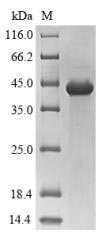The expression region of this recombinant Human PSMB8 covers amino acids 73-276. The expected molecular weight for the PSMB8 protein is calculated to be 42.7 kDa. This protein is generated in a e.coli-based system. The PSMB8 coding gene included the N-terminal 10xHis-SUMO tag and C-terminal Myc tag, which simplifies the detection and purification processes of the recombinant PSMB8 protein in following stages of expression and purification.
The proteasome subunit beta type-8 (PSMB8) is a subunit of the immunoproteasome, a specialized form of the proteasome involved in antigen presentation. The immunoproteasome plays a crucial role in the major histocompatibility complex (MHC) class I antigen processing pathway, generating peptides for presentation on the cell surface to cytotoxic T lymphocytes. PSMB8 is specifically incorporated into the immunoproteasome, influencing its catalytic properties and enhancing the production of peptides for MHC class I molecules. Research on PSMB8 is significant in understanding immune responses, inflammatory processes, and autoimmune diseases. Dysregulation of PSMB8 has been implicated in various autoimmune conditions, highlighting its potential as a target for therapeutic interventions aimed at modulating immune responses.






